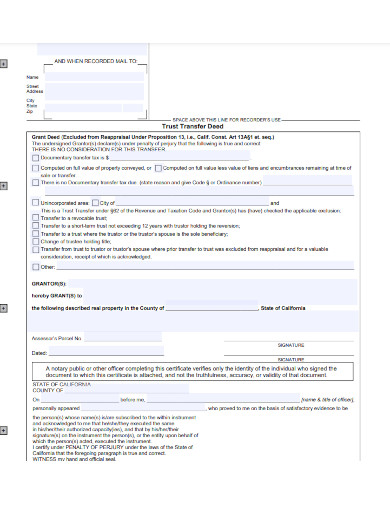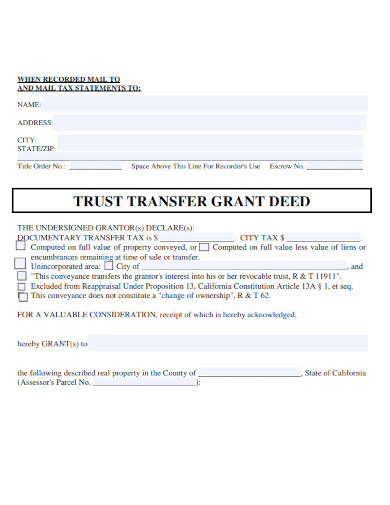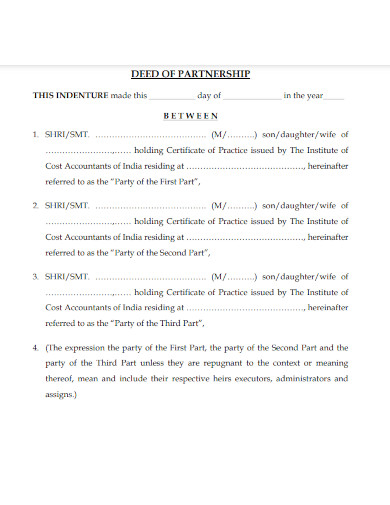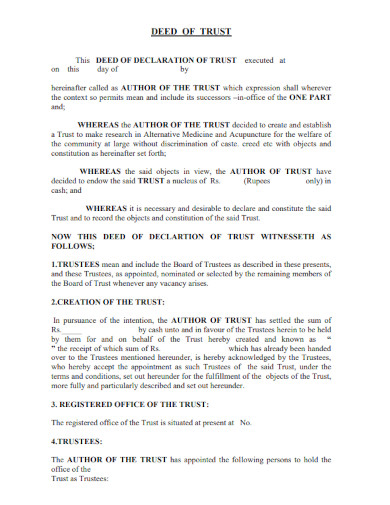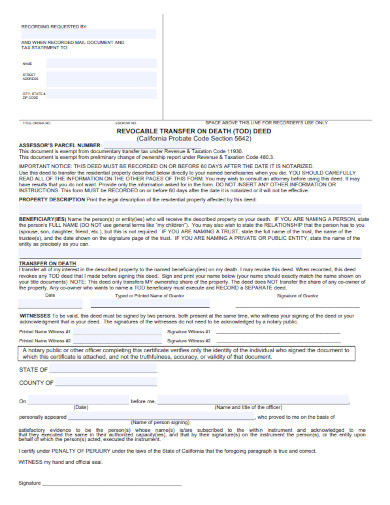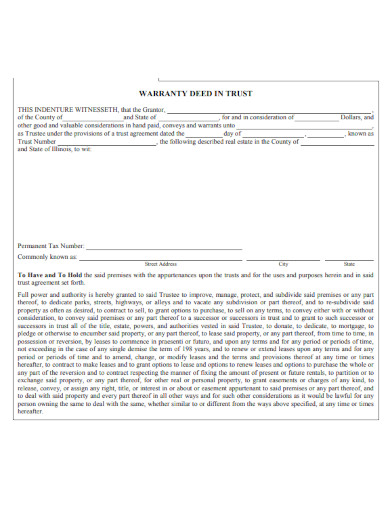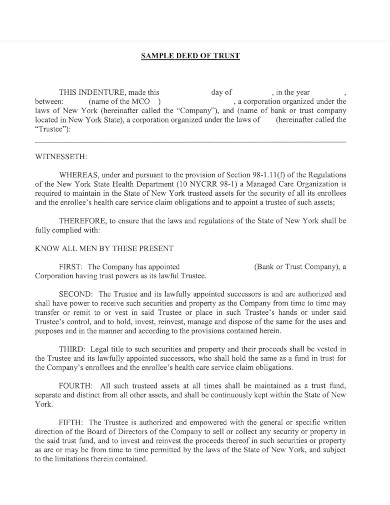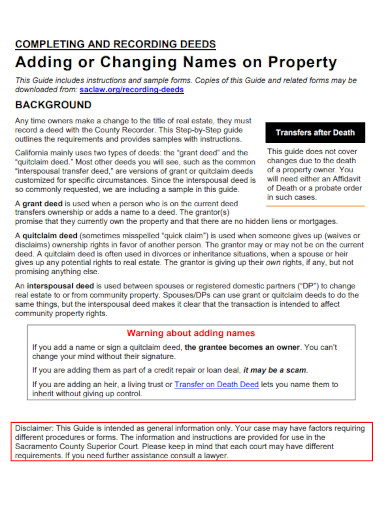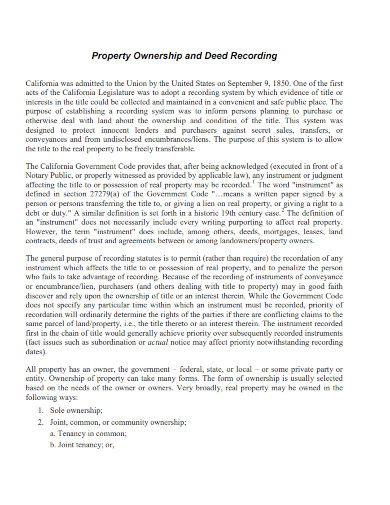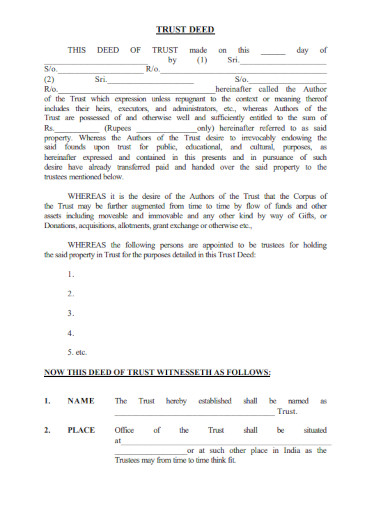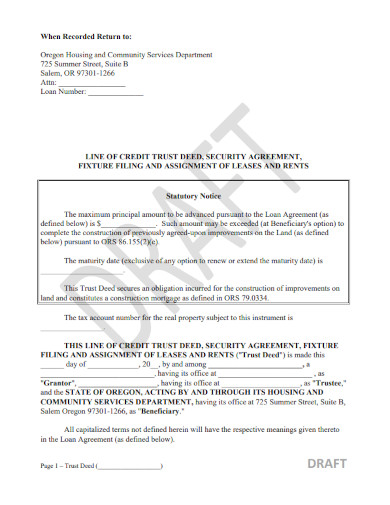A lender offers the borrower money in exchange for one or more promissory notes attached to a trust deed in a property transaction, such as the purchase of a property. This deed gives an impartial trustee, such as a title company, escrow business, or bank, legal ownership to the real property, which is held as collateral for the promissory notes. The borrower retains equitable title—the right to achieve complete ownership—as well as full usage and accountability for the property. This state of things persists throughout the loan’s repayment tenure. Until the borrower pays the debt in full, the trustee controls the legal title to the property, which then passes to the borrower.
10+ Trust Transfer Deed Samples
A trust deed, sometimes known as a deed of trust, is a type of real estate contract used in the United States. It’s a legal document that plays a part when one party borrows money from another to buy a house. The trust deed is a contract between a borrower and a lender that the property will be kept in trust by an unbiased and impartial third party until the loan is paid off. Despite the fact that trust deeds are less frequent than they once were, 20 states still require the use of one instead of a mortgage when financing the acquisition of real estate.
1. Trust Transfer Deed
2. Trust Transfer Grant Deed
3. Deed of Trust Transfer Template
4. Trust Transfer Deed Example
5. Revocable Trust Transfer on Death Deed
6. Warranty Transfer Deed in Trust
7. Sample Trust Transfer Deed
8. Completing Recording Trust Transfer Deed
9. Property Ownership Trust Transfer Deed
10. Trust Transfer Deed
11. Lift Trust Transfer Deed
Preparing the Deed
To begin, obtain a deed form. Look for one that is tailored to your state. You should be able to locate one on the internet. You might also be able to find one at a local law library; seek for books on “real property” that feature photocopy-able deed forms. A “quitclaim” or “grant” deed can be used.
Although deed forms differ slightly, they all require the same basic information. Enter the following:
- The names of the current owners. Solely your name appears here if you are the single owner or if you and another co-owner are transferring only your portion of the property. Type both of your names if you and your partner own the estate together and are moving it to a shared trust. Use the exact same spelling of your name as on the deed that conveyed the property to you and on the living trust paperwork.
- The name of the new owner. Fill in your name(s), as trustee(s), and the date you filed the trust agreement in front of a notary public precisely as it appears in the first section of your trust document.
- This is the property’s “legal description.” Exactly as it exists on the preceding deed, copy the description.
If you co-own the estate with someone and are only transferring your portion, you must also specify whether you’re passing “all your interest” in the estate or only that portion (a one-half stake, for example) in the legal description.
FAQs
How do you record the deed?
After you’ve signed the deed, you’ll need to “register” it, which means you’ll need to file a copy of the notarized deed with the county office that preserves local property records. The land records office is also known as the county recorder’s office, land registry office, or county clerk’s office in most countries. Simply go to the land records office with the actual, signed deed. A clerk will create a copy and file it in the public records for a modest fee. Your original will be returned to you, together with a reference number indicating where the copy may be found in the public records.
What are the similarities of a trust deed and a mortgage?
Both trust deeds and mortgages are used to create liens on property investment in bank and private loans, and both are usually registered as debt in the area where the property is located.
If you want to see more samples and formats, check out some trust transfer deed samples and templates provided in the article for your reference.
Related Posts
FREE 14+ Sample Music Concert Proposal Templates in MS Word | Google Docs | Pages | PDF
FREE 10+ Security Guard Contract Samples in PDF | MS Word
FREE 10+ Assurance Agreement Samples In MS Word | Google Docs | Apple Pages | PDF
FREE 10+ Option to Purchase Agreement Samples in MS Word | Apple Pages | PDF
FREE 26+ Curriculum Form Samples in MS Word | PDF
FREE 20+ Cleaning Service Proposal Samples in PDF | MS Word
FREE 29+ Sample Loan Application Form Templates in MS Word | PDF
FREE 10+ Event Venue Contract Samples in PDF | MS Word | Pages | Google Docs
FREE 10+ SBAR Samples in PDF | DOC
FREE 12+ Music Band Contract Templates in PDF | MS Word
FREE 10+ HVAC Maintenance Contract Samples in PDF | MS Word
FREE 10+ Social Media Marketing Contract Samples in MS Word | PDF
FREE 10+ Wholesale Assignment Contract Samples in PDF
FREE 18+ Financial Proposal Samples in PDF | MS Word | Google Docs | Pages
FREE 10+ Feasibility Study Samples in PDF

